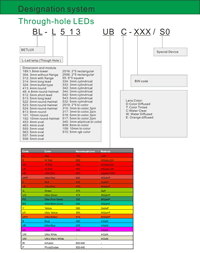Discrete LED
Series No:
Weight:(g/pcs)
Dimension:(mm)
Package:
Specification:
Inquiry
Description:
Introduction: Lighting Efficiency Redefined by 1 Watt LED
The 1 watt LED, a marvel in the high power LED category, epitomizes efficiency and potency in a diminutive package. Widely acclaimed for its minimal energy requirements and significant light output, the 1w LED is reshaping expectations in the lighting industry.
Features That Shine Through
- Energy Efficiency: The hallmark of 1w LEDs, offering substantial light output while consuming minimal power.
- Compact Size: Their small footprint enables integration into various designs, from intricate electronics to expansive lighting systems.
- Durability: Known for their longevity, these LEDs withstand extensive use, reducing the need for frequent replacements.
- Versatility: The broad spectrum of applications showcases their adaptability, from residential lighting to complex industrial setups.
A Spectrum of Applications
The utility of 1 watt LEDs extends across domains, illustrating their flexibility. They are pivotal in task lighting, decorative applications, and as vital components in electronic devices, where precision lighting is paramount.
The Bright Side of 1w LEDs
Opting for 1 watt LEDs brings a plethora of advantages, including enhanced energy savings, a lower carbon footprint, and superior longevity. These benefits underscore the LEDs’ role in promoting sustainable and cost-effective lighting solutions.
Illuminating Success: Case Studies
This segment highlights the transformative effect of 1 watt LEDs in various industries, from revolutionizing home lighting to pioneering advancements in medical instrumentation, demonstrating their broad impact and utility.
Echoes of Innovation: User Testimonials
Testimonials from professionals who have embraced 1 watt LEDs offer insights into their effectiveness and versatility. Feedback emphasizes the improved performance, energy efficiency, and innovative applications unlocked by these high power LEDs, cementing their esteemed status in the lighting domain.
Conclusion: Embracing a Brighter Future with 1 Watt LED Technology
The exploration of 1 watt LEDs in high power applications paints a picture of a future where efficient, reliable, and versatile lighting solutions are paramount. As technology advances, the pivotal role of these LEDs in spearheading sustainable, innovative lighting designs becomes increasingly clear.
Call to Action
For those at the forefront of electronics manufacturing and design, incorporating 1 watt LEDs into your projects is a strategic move towards embracing efficient, innovative, and sustainable lighting solutions. Explore the potential of these compact yet powerful LEDs and light up your initiatives with unparalleled brilliance and efficiency.
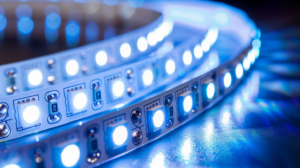
Features
- 1W Power Rating: These LEDs are designed to operate at 1 watt, striking a balance between energy efficiency and sufficient brightness for a range of lighting needs.
- Suitability for Illumination and Decorative Lighting: Their brightness level makes them ideal for both functional lighting in lamps and for decorative purposes.
- Long Service Life: Offering up to 50,000 hours of operation, these LEDs are built for longevity, reducing the need for frequent replacements.
- Low Luminosity Loss: Throughout their lifespan, these LEDs maintain their brightness, ensuring consistent light output.
- Variety of Emitting Colors: Available in multiple colors, they provide flexibility for different design and aesthetic requirements.
- Working Current Range: Designed to operate efficiently at a current range of 200-350mA, making them compatible with a variety of power supplies and drivers.
- Optional Heat Sink: Available with or without a heat sink. The inclusion of a heat sink is beneficial for managing heat dissipation, crucial for maintaining performance and longevity, especially in high-power applications.
Applications
- General Lighting: Ideal for residential and commercial lighting fixtures, providing efficient and long-lasting illumination.
- Architectural and Decorative Lighting: Their color variety and compact size make them suitable for accent lighting, mood lighting, and creating ambiance in spaces.
- Outdoor Lighting: Can be used in landscape lighting, garden lights, pathway illumination, and outdoor decorative installations.
- Display Lighting: Suitable for use in display cases, retail lighting, and exhibition spaces where consistent and bright illumination is needed.
- Specialty Lighting: Employed in task lighting, studio lighting, or areas requiring focused, intense lighting.
- Automotive Lighting: Utilized in automotive lighting systems for interior and exterior applications.
- DIY Projects and Custom Lighting Solutions: Popular among hobbyists and for custom lighting projects due to their ease of use and versatility.


Electrical-optical characteristics:
Article No | color | material | wavelength | apperance | v_typ | v_max | luminous_min | luminous_typ | degree |
|---|---|---|---|---|---|---|---|---|---|
BL-HP7EBGC |
Ultra Bluish Green |
505 |
Water Clear |
3.8 |
40 |
50 |
120 |
||
BL-HP7EPGC |
Ultra Pure Green |
525 |
Water Clear |
3.8 |
50 |
60 |
120 |
||
BL-HP7EUBC |
Ultra Blue |
470 |
Water Clear |
3.8 |
10 |
15 |
120 |
||
BL-HP7EUEC |
Ultra Orange |
630 |
Water Clear |
2.75 |
35 |
45 |
120 |
||
BL-HP7EUW2C |
Ultra Warm White |
3200k |
Water Clear |
3.8 |
50 |
70 |
120 |
||
BL-HP7EUWC |
Ultra White |
6000k |
Water Clear |
3.8 |
70 |
90 |
120 |
||
BL-HP7EUYC |
Ultra Yellow |
590 |
Water Clear |
2.75 |
35 |
45 |
120 |
Package configuration & Internal circuit diagram
Obtain 3D specification files
To examine all 3D specifications, save the files to your local drive and open them with your 3D application.
Lens colors in 3D files are solely for visual representation; consult the Datasheet for accurate lens type and color information.
In the event of a mismatch, the dimensions in the datasheet take precedence over the 3D specifications.
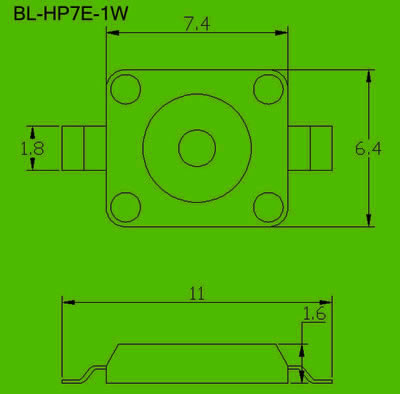
All dimensions are in millimeters(inches)
Tolerance is +-0.25(0.01″) unless otherwise note
Specifications are subject to change without notice.
Partno description:
More Information
Lens Color:
| Code | D | T | C | W | E | |
| Meaning | color Diffused | Color Tinted | Water Clear | Water Diffused | Orange diffused |
Absolute maximum ratings (Ta=25°C)
| Parameter | SR | LR | UR | UE | UY | UG | PG | BG | B | UB | UV | W | Unit |
| Forward Current I F | 25 | 25 | 25 | 30 | 30 | 30 | 30 | 30 | 30 | 30 | 30 | 30 | mA |
| Power Dissipation P d | 60 | 60 | 60 | 65 | 65 | 75 | 110 | 110 | 120 | 120 | 120 | 120 | mW |
| Reverse Voltage V R | 5 | 5 | 5 | 5 | 5 | 5 | 5 | 5 | 5 | 5 | 5 | 5 | V |
| Peak Forward Current I PF (Duty 1/10 @1KHZ) | 150 | 150 | 150 | 150 | 150 | 150 | 150 | 100 | 100 | 100 | 100 | 100 | mA |
| Operation Temperature T OPR | -40 to +80 | °C | |||||||||||
| Storage Temperature T STG | -40 to +85 | °C | |||||||||||
| Lead Soldering Temperature T SOL | Max.260+-5°C for 3 sec Max. (1.6mm from the base of the epoxy bulb) | °C | |||||||||||
Related Information
Applied for:

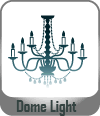
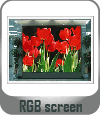
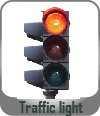
The LEDs described here are intended to be used for ordinary electronic equipment (such as office equipment,
communication equipment and household applications). Consult Betlux’s Sales in advance for information on
applications in which exceptional reliability is required, particularly when the failure or malfunction of the LEDs
may directly jeopardize life or health (such as in aviation, transportation, traffic control equipment, medical
and life support systems and safety devices).
CAUTIONS for Through-Hole LED Lamps
1. Application
The LEDs described here are intended to be used for ordinary electronic equipment (such as office equipment, communication equipment and household applications). Consult Betlux’s Sales in advance for information on applications in which exceptional reliability is required, particularly when the failure or malfunction of the LEDs may directly jeopardize life or health (such as in aviation, transportation, traffic control equipment, medical and life support systems and safety devices).
2. Storage
The storage ambient for the LEDs should not exceed 30℃ temperature or 70% relative humidity. It is
recommended that LEDs out of their original packaging are used within three months
For extended storage out of their original packaging, it is recommended that the LEDs be stored in a sealed
container with appropriate desiccant or in a desiccator with nitrogen ambient.
3. Cleaning
Use alcohol-based cleaning solvents such as isopropyl alcohol to clean the LED if necessary
4. Lead Forming & Assembly
During lead forming, the leads should be bent at a point at least 3mm from the base of LED lens. Do not use
the base of the leadframe as a fulcrum during forming.
Lead forming must be done before soldering, at normal temperature.
During assembly on PCB, use minimum clinch force possible to avoid excessive mechanical stress.
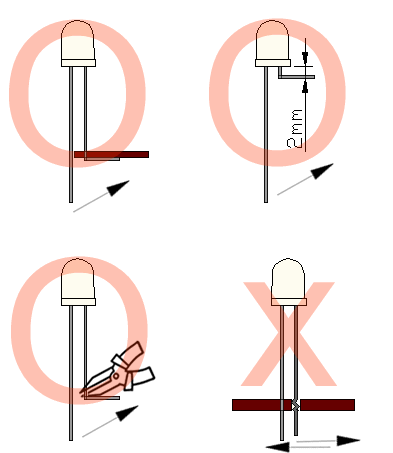
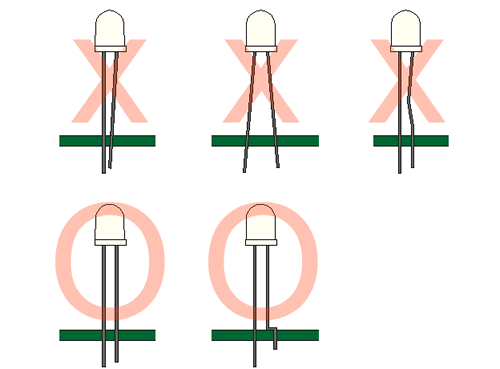
Soldering
When soldering, leave a minimum of 2mm clearance from the base of the base of the lens to the soldering point. Dipping the lens into the solder must be avoided.
Do not apply any external stress to the lead frame during soldering while the LED is at high temperature.
Recommended soldering conditions:
| IR Reflow Soldering (for SMD display) | Wave Soldering | Soldering Iron | |||
| Pre-Heat | 150-180°C | Pre-Heat | 100°C Max. | Temperature | 300°C Max. |
| Pre-Heat Time | 120sec Max. | Pre-Heat Time | 60sec Max. | ||
| Peak Temperature | 260°C Max. | SolderWave | 260°C Max. | Soldering Time | 3sec Max.(one time only) |
| Soldering Time | 10 sec Max. | Soldering Time | 5sec Max. | ||
Note: Excessive soldering temperature and/or time might result in deformation of the LED lens or failure of the LED
ESD(Electrostatic Discharge)
Static Electricity or power surge will damage the LED.
Suggestions to prevent ESD (Electrostatic Discharge):
n Use a conductive wrist band or anti-electrostatic glove when handling these LEDs
n All devices, equipment, and machinery must be properly grounded
n Work tables, storage racks, etc. should be properly grounded
n Use ion blower to neutralize the static charge which might have built up on surface of the LED’s
plastic lens as a result of friction between LEDs during storage and handling
ESD-damaged LEDs will exhibit abnormal characteristics such as high reverse leakage current,
low forward voltage, or “no light on” at low currents. To verify for ESD damage, check for “light on”
and Vf of the suspect LEDs at low currents.
The Vf of “good” LEDs should be>2.0V@0.1mA for InGaN product and >1.4V@0.1mA for AlInGaP
product.

Drive Method
An LED is a current-operated device. In order to ensure intensity uniformity on multiple LEDs connected in
parallel in an application, it is recommended that a current limiting resistor be incorporated in the drive circuit,
in series with each LED as shown in Circuit A below.
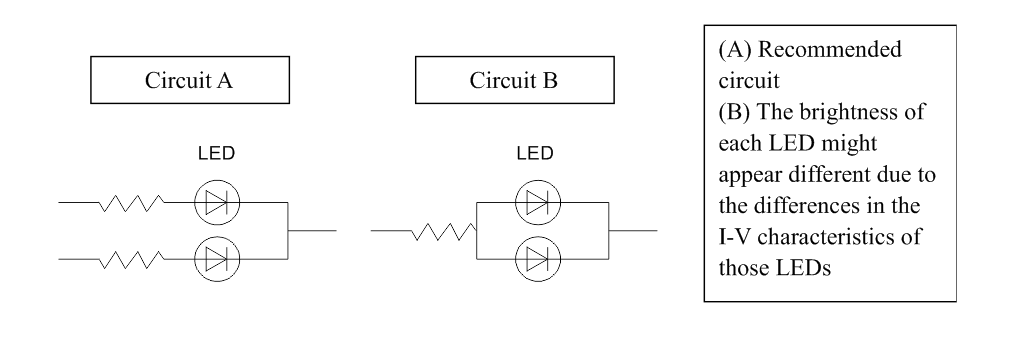
When selecting power for LED systems, it’s essential to understand several key parameters to ensure safe operation, longevity, and optimal performance. Here are some steps and considerations for LED power selection:
- Determine the Forward Voltage (Vf) of the LED(s):
Each LED has a forward voltage, which is the voltage at which the LED operates when the current is flowing through it. This value can typically be found in the LED’s datasheet.
- Determine the Forward Current (If) of the LED(s):
The forward current is the current at which the LED is designed to operate. Running an LED at higher than its rated current can reduce its lifespan and increase the heat it produces.
- Decide on the Configuration:
Series Configuration: When LEDs are connected in series, the forward voltages add up, but the current remains the same.
Parallel Configuration: When LEDs are connected in parallel, the forward voltage remains the same, but the currents add up. This configuration can be risky because if one LED fails or has a slightly lower forward voltage, it can cause the other LEDs to draw more current.
Calculate Total Power Requirements:
Power (W) = Total Forward Voltage (V) x Total Forward Current (A)
For example, if you have three LEDs connected in series, each with a forward voltage of 3V and a forward current of 20mA, the total power requirement would be:
Power = (3V + 3V + 3V) x 20mA = 9V x 0.02A = 0.18W
- Select an Appropriate Power Supply:
- Voltage Rating: The power supply voltage should match or slightly exceed the total forward voltage of your LED configuration.
- Current Rating: The power supply’s current rating should meet or exceed the total forward current of your LED configuration.
- Safety Margin: It’s a good practice to select a power supply that can provide at least 20% more power than your calculated requirement. This ensures the power supply isn’t operating at its maximum capacity, which can extend its life and ensure safer operation.
- Consider Additional Features:
- Dimming Capability: If you want to control the brightness of your LEDs, choose a power supply with dimming capabilities.
- Overcurrent and Overvoltage Protection: To protect your LEDs, select a power supply with built-in protection mechanisms.
- Thermal Management: Ensure that the power supply has adequate cooling, especially if it will be enclosed or in a location with limited airflow.
- Regulation and Efficiency:A power supply with good regulation will maintain a consistent voltage output despite variations in the load. High efficiency ensures minimal power is wasted as heat.
- Physical Size and Form Factor:Depending on where you plan to place the power supply, its size and shape may be critical factors.
In summary, when selecting power for LED systems, understanding your LED’s requirements and the configuration you plan to use is essential. Then, pick a power supply that meets those needs with some added safety margin, keeping in mind any additional features or constraints relevant to your project.
Here are some well-regarded brands in the industry:
- Mean Well: One of the most recognized brands in the LED power supply industry, Mean Well offers a wide range of products suitable for both indoor and outdoor applications. Their units often come with features like overcurrent protection, dimming capabilities, and high efficiency.
- Tridonic: A global leader in lighting technology, Tridonic offers LED drivers and power supplies that cater to various lighting solutions, from simple setups to advanced smart lighting systems.
- Philips Advance Xitanium: Philips is a well-known brand in the lighting industry, and their Xitanium series of LED drivers are known for reliability and performance. They cater to both indoor and outdoor LED applications.
- Osram: Another giant in the lighting industry, Osram offers a range of LED drivers and power supplies suitable for various applications, including architectural and street lighting.
- LIFUD: Specializing in LED drivers, LIFUD is known for its high-quality products that cater to both commercial and residential LED lighting solutions.
- MOSO: This brand offers a variety of LED drivers, especially for outdoor and industrial applications. Their products are known for durability and performance.
- TDK-Lambda: With a history in power electronics, TDK-Lambda offers a range of power supplies and LED drivers suitable for various applications, emphasizing reliability and advanced features.

